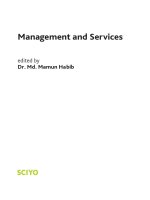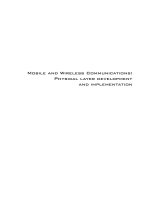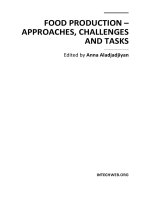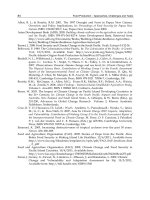Food Production Approaches, Challenges and Tasks Part 1 docx
Bạn đang xem bản rút gọn của tài liệu. Xem và tải ngay bản đầy đủ của tài liệu tại đây (1.38 MB, 19 trang )
FOOD PRODUCTION –
APPROACHES, CHALLENGES
AND TASKS
Edited by Anna Aladjadjiyan
Food Production
–
Approaches, Challenges and Tasks
Edited by Anna Aladjadjiyan
Published by InTech
Janeza Trdine 9, 51000 Rijeka, Croatia
Copyright © 2011 InTech
All chapters are Open Access distributed under the Creative Commons Attribution 3.0
license, which allows users to download, copy and build upon published articles even for
commercial purposes, as long as the author and publisher are properly credited, which
ensures maximum dissemination and a wider impact of our publications. After this work
has been published by InTech, authors have the right to republish it, in whole or part, in
any publication of which they are the author, and to make other personal use of the
work. Any republication, referencing or personal use of the work must explicitly identify
the original source.
As for readers, this license allows users to download, copy and build upon published
chapters even for commercial purposes, as long as the author and publisher are properly
credited, which ensures maximum dissemination and a wider impact of our publications.
Notice
Statements and opinions expressed in the chapters are these of the individual contributors
and not necessarily those of the editors or publisher. No responsibility is accepted for the
accuracy of information contained in the published chapters. The publisher assumes no
responsibility for any damage or injury to persons or property arising out of the use of any
materials, instructions, methods or ideas contained in the book.
Publishing Process Manager Ana Skalamera
Technical Editor Teodora Smiljanic
Cover Designer InTech Design Team
First published January, 2012
Printed in Croatia
A free online edition of this book is available at www.intechopen.com
Additional hard copies can be obtained from
Food Production – Approaches, Challenges and Tasks, Edited by Anna Aladjadjiyan
p. cm.
ISBN 978-953-307-887-8
free online editions of InTech
Books and Journals can be found at
www.intechopen.com
Contents
Preface IX
Part 1 Sustainable Food Production: Case Studies 1
Chapter 1 To Meet Future Food Demands We Need to Change
from Annual Grain Legumes to Multipurpose
Semi-Perennial Legumes 3
Henning Høgh-Jensen
Chapter 2 Issues in Caribbean Food Security:
Building Capacity in Local Food Production Systems 25
Clinton Beckford
Chapter 3 Permanent Internal Migration as Response
to Food Shortage: Implication to Ecosystem
Services in Southern Burkina Faso 41
Issa Ouedraogo, Korodjouma Ouattara,
Séraphine Kaboré/Sawadogo, Souleymane Paré and Jennie Barron
Chapter 4 Food Security and Challenges of Urban
Agriculture in the Third World Countries 55
R.A. Olawepo
Chapter 5 Climate Change Implications for Crop
Production in Pacific Islands Region 67
Morgan Wairiu, Murari Lal and Viliamu Iese
Chapter 6 Strengthening Endogenous Regional
Development in Western Mexico 87
Peter R.W. Gerritsen
Chapter 7 Enhanced Food Production by Applying
a Human Rights Approach – Does Brazil Serve
as a Model of Best Practice? 103
Hans Morten Haugen
VI Contents
Chapter 8 Achieving Household Food Security:
How Much Land is Required? 127
P. Ralevic, S.G. Patil and G.W. vanLoon
Part 2 Scientific Methods for Improving
Food Safety and Quality 143
Chapter 9 Physical Factors for Plant Growth
Stimulation Improve Food Quality 145
Anna Aladjadjiyan
Chapter 10 Milk Biodiversity: Future Perspectives of
Milk and Dairy Products from Autochthonous
Dairy Cows Reared in Northern Italy 169
Ricardo Communod, Massimo Faustini,
Luca Maria Chiesa, Maria Luisa Torre,
Mario Lazzati and Daniele Vigo
Chapter 11 Rapid Methods as Analytical Tools for Food and Feed
Contaminant Evaluation: Methodological
Implications for Mycotoxin Analysis in Cereals 185
Federica Cheli, Anna Campagnoli,
Luciano Pinotti and Vittorio Dell’Orto
Chapter 12 Natural Hormones in Food-Producing Animals:
Legal Measurements and Analytical Implications 205
Patricia Regal, Alberto Cepeda and Cristina A. Fente
Chapter 13 Aluminium in Acid Soils: Chemistry,
Toxicity and Impact on Maize Plants 231
Dragana Krstic,
Ivica Djalovic,
Dragoslav Nikezic and Dragana Bjelic
Chapter 14 Genetic Characterization of Global Rice
Germplasm for Sustainable Agriculture 243
Wengui Yan
Preface
Contemporary development of mankind is facing two main problems – food
insufficiency and energy shortage. Both are consequences of a fast growing of human
population – today the world's population has reached 7 billion and the birthrate is
expected to prevail in developing countries. The rising human population needs more
food and more energy for high-quality life. Both requirements are in concurrence as
far as the raw materials for food production and for energy from renewable sources
are often the same.
This book is dedicated to food production and the problems associated with the
satisfaction of food needs in different parts of the world. On one hand, the emerging
food crisis requires development of sustainable food production and on the other
hand, the quality and safety of the food produced should be guaranteed. The book is
divided in two sections; the first section is related to social issues rising from food
insufficiency in the third world countries, and is titled “Sustainable food production:
Case studies”.The second section is titled “Scientific methods for improving food
quality and safety” and covers the problems caused by the use of artificial compounds
for increasing food production, and the methods for improvement of food quality and
safety.
The first section of the book contains 8 chapters.
The necessity of innovative approaches in food production and consumption is
discussed in Chapter 1 – “To meet future food demands we need to change from
annual grain legumes to multipurpose semi-perennial legumes”, written by Henning
Høgh-Jensen. This chapter investigates the possibilities for introduction of new models
of plant breeding for sustainable food production in Southern and Eastern semi-
arid.Food security in the Caribbean and Jamaica, and the necessity of building
capacity of local food producers are covered by Clinton Beckford in Chapter 2. The
gender issue as a possibility to increase food production and build-up food security
and sustainability is also considered.
Chapter 3, written by Ouedraogo et al. is focused on food shortage in Burkina Faso
and its reflection on the ecosystem as a consequence of population dynamics and land
X Preface
use changes. The impact of traditional farming systems of four ethnical groups on the
ecosystem is investigated.
The problems of food security and the impact of urban agriculture in third world
countries with the example of Nigeria are in described in Chapter 4, written by
Olawepo. The impact of rural-urban migration on food shortage could be decreased if
any form of economic activities involving food production, farming, marketing and
animal husbandry would be practiced by urban residents, within the city, around it,
and in rural land areas surrounding the city. This industry is rather spread-out in the
developing countries and could favorably affect food sustainability.
It is well known that the plant production depends strongly on climate changes.
Implications of climate change on crop production in Pacific Islands region are
investigated in Chapter 5, written by Morgan Wairiu, Murari Lal, and Viliamu Iese.
The negative impact of globalization on the regional agricultural development of
western Mexico, and the perspectives for new rural development as a solution of the
problem are discussed in chapter 6, written by Peter Gerritsen.
In chapter 7, Hans Morten Haugen studies the impact of human rights on the
enhancement of food production in Brazil. Both concurrent possibilities for food
(sugar) or energy (bioethanol) production are taken into account.
In chapter 8, Ralevich et al. explore what is the minimum land area necessary to satisfy
the food and fodder requirements of households’ needs on the basis of primary field
data in Southern India .
The second section is comprised of 6 chapters.
Chapter 9 by A.Aladjadjiyan discusses the substitution of chemical additives for plant
protection and soil fertilizers with physical methods of plant treatment. The
effectiveness of irradiation with electromagnetic waves from different sources and
parts of electromagnetic spectrum, treatment with static magnetic field and ultrasound
is also discussed.
Chapter 10 refers to food quality and security control. F. Cheli et al. examine
possibilities for objective assessment of food quality and security. Authors conclude
that existing rapid analytical approaches can be optimized and applied for control of
contaminants and undesirable substances in food. Special attention is paid to the
sampling procedure.
The following two chapters of the book cover animal husbandry. The problems of
autochthonous diary cattle breeding in Northern Italy are in the focus of Chapter 11,
written by R. Communod et al. The impact of breeding on conservation of
biodiversity, and functional and sensory properties of dairy products is discussed.
Preface XI
Regal, Cepeda and Fente consider the impact of natural hormones in food producing
animals on human health in Chapter 12. A comparison of EU and US legislation in this
matter, and its impact on the trade is presented. The conclusion is that the methods of
hormone abuse in livestock production need to be further developed.
The impact of soil acidity on productivity and quality of maize plants is the topic of
Chapter 13, written by Dragana Krstic et al. The role of aluminium in soil acidity and
toxicity, and its influence on the insufficient development of maize root is clarified.
Finally, Chapter 14, written by Yan Wengui presents genetic characterization of rice
germplasm and its impact on sustainable rice production. The rice collection of USDA
gene bank, geographic analysis of global rice and genetic relationships among
geographic regions are discussed.
This book will fill the gaps in the knowledge about different aspects of sustainable and
safe food production. It will be an interesting and helpful resource to specialists and
students in the field of Food Production.
Dr. Anna Aladjadjiyan
Agricultural University, Plovdiv
Bulgaria
Part 1
Sustainable Food Production: Case Studies
1
To Meet Future Food Demands We Need to
Change from Annual Grain Legumes to
Multipurpose Semi-Perennial Legumes
Henning Høgh-Jensen
Department of Environmental Science,
Aarhus University,
Denmark
1. Introduction
The last meal of an Iron Age man buried in a Danish bog included at least 60 plant species,
including barley, linseed and species we now consider weeds. A modern man relies in
contrast on a remarkable small number of crop plants, mostly cereal stables like wheat, rice
and maize (Evans, 1998). Both land and people in Sub-Saharan Africa are suffering. Natural
resource management is in distress and most rural Africans remain poor and food insecure
despite widespread macroeconomic, political and sectorial reforms. Most predictions are
that these Africans will remain food insecure in the foreseeable future (Pinstrup-Andersen &
Pandya-Lorch, 2001). Innovations are, however, changing this landscape much faster than
we could expect.
A market-oriented agriculture has been promoted by many agents of change. And change is
happening. The last 10 years a renewed optimism has taking root in the fact that a number
of African countries are demonstrating high economic growth rates (Radelet, 2010). We do
not know the winners and the losers yet – just that they are there. Not all farmers will have
the capacity to join the market orientations by high-value commodities. They are simply not
able to innovate.
Nitrogen is a major limiting nutrient for food production but the growing demand for food
is met in two ways. One through fossil fuel driven fixation of nitrogen, Haber-Bosch
nitrogen (Erisman et al., 2008), is one way and symbiotic fixation of nitrogen, leguminous
nitrogen (Giller, 2001), is the other. Feeding approximately half of humanity is made
possible by Haber-Bosch nitrogen, the other half by leguminous nitrogen. With the current
focus on reducing emissions of greenhouse gasses while simultaneously increasing the
biomass production for food, fibre, feed and fuel, the use efficiency of the leguminous
nitrogen must be improved.
Annual grain legumes basically satisfy their own need for nitrogen via their capability for
fixing atmospheric nitrogen (see e.g. Unkovich et al., 2010). However, they seldom
contribute much to soil fertility or to subsequent crops. Further, due to their annual
structure they must be reseeded every season with consequences for investing resources and
Food Production – Approaches, Challenges and Tasks
4
potential susceptibility for unfavourable growth conditions during the renewed crop
establishment phase.
Legume seeds hold a carbon-nitrogen ratio of approximately 10 compared to values up to 30
for cereals. Thus from a diet point of view, grain legumes are very valuable protein sources.
This importance has been recognized since ancient history (Cohen, 1977). In addition to the
nitrogen located in the grain, some nitrogen pools are located in the residues, which can be
utilized for fodder or returned to the soil. Another important leguminous nitrogen pool is in
the roots and rhizodeposits (Wichern et al., 2008).
2. Innovation
Innovation is a buzz-word and there are a multitude of definitions. Within the business
management literature, innovation is mostly seen as a tool used by entrepreneurs to create a
resource that will give them an advantage over their competitors (Drucker, 1985, p. 27). Or
more broadly, some see an innovation in an idea, practice or object that is new to the
individual; a newness that gives a value to the individual when implemented (Rogers &
Shoemakers, 1971, p. 19; Urabe, 1988, p. 3). So we can say that innovation is linked to
entrepreneurs and it represents newness, it has a relation to invention or to its process of
adoption and is as such both a process and an outcome, where the final feature of involving
change or a discontinuity with the prevailing product/service or market paradigm may be
the most important.
Innovation can be triggered by many factors. It may be a farmer that explores new
possibilities to solve an irritating problem. Or it may be a social way of responding and
adapting to changes in access to natural resources, assets or markets. The photo in Figure 1
illustrates an innovation developed by the entrepreneur AMFRI Farm, a private company in
Uganda exporting organic fruits, species and pulps overseas. The plastic bag contains just
two different chillies, a ginger tuber and lemongrass. Based on this simple combination, the
net profit per unit of specie is larger than if each species is sold in bulk amounts.
The innovation is that one bag fits into a busy dinner-shopping westerner who like fresh
spices but do not want to buy a whole lot of chillies. The innovation is that it gives an
important value to the customer; a value which makes the customer very little sensitive to
how many cents that she is paying per individual chilli. And it is all packed in one little bag
– ready to be shopped and go! Other examples of such market-oriented value chain
innovations are testing of consumers preferences. Jones et al. (2002) describes how green
pods of pigeonpea were presented to a UK market segment and how they responded to
colour differences in the pods.
A cropping-oriented form of innovations is a more local oriented innovation than market-
oriented innovation often are, simply because it has to take into account the spatial
variability in soil fertility, precipitation, crop growth preferences, etc. The innovations are
often found in the management of the crops. Examples of such documented and published
innovation include the development of MBILI systems (Woomer et al., 2004) in Kenya where
double rows of legumes and cereals are planted to decrease the competitive pressure on the
legumes. Another is the push-pull plant protection technologies developed by the
international research institute ICIPE (Khan et al., 2011), which by planting designs try to
manipulate the pests.
To Meet Future Food Demands We Need to Change
from Annual Grain Legumes to Multipurpose Semi-Perennial Legumes
5
Fig. 1. Illustration of innovations at AMFRI FARMS LTD.’s packing site in Kampala,
Uganda. Photo by Henning Høgh-Jensen.
Other forms of innovations take place in research. This includes the researcher developed
but farmer-centred models of plant breeding (Bänzinger et al., 2006) or the introduction of
modern varieties of pigeonpea in eastern and southern Africa (Myaka et al., 2006); the latter
we will return to later. Innovations also include the attempts to let nutrient additions solve
the lack of yields by a micro-dosing approach (Twomlow et al., 2010) that basically reflects
the denial of scientists to accept that inorganic fertilizers are not used by farmers for stable
cereals, thereby also the failure of the Green Revolution technology package in Africa.
Such approaches generally assume that response curves are favourable, e.g. generating
approximately 5 kg of additional grain for each kg of applied inorganic nitrogen. The
example of Twomlow et al. (2010), however, demonstrates that the scientists apparently
never checked the socioeconomic conditions for the farmers but only tested the geophysical-
Food Production – Approaches, Challenges and Tasks
6
ecological conditions by trials across multiple farms. They did not ask the simple question to
the farmer: “are you able to pay for this investment?”
Three long-term experiments in Africa, one each from Kenya, Nigeria and Burkina Faso,
outline the basic concept that we operate under this sub-continent. The extracted outcome
from Kapkiyai et al. (1999) presented in Figure 2 illustrates the benefits on crop yields of
feeding the soil various carbon sources. Franke et al. (2008) and Bostick et al. (2007) largely
support the learnings from these empirical effects of various technologies on yield and soil
quality. Table 1 illustrates a practical finding from such trials, namely that the total soil
carbon content only change little and slowly but it is in the intermediate carbon pools that
the management differences are detectable. Similar findings under Asian conditions have
been presented by Wen (1984), by Khan et al. (2007 for North American conditions, and
under North Scandinavian conditions by Ågren & Bosatta (1996).
Fig. 2. Long-term effect of residue/manure management in Kabete, Kenya, after 18 yr on a
Humic Nitisol. Manure signifies 10 tonnes farm yard manure per hectare and N signifies 120
kg nitrogen and 52 kg phosphorus per hectare in inorganic fertilizers (modified from
Kapkiyai et al., 1999).
To Meet Future Food Demands We Need to Change
from Annual Grain Legumes to Multipurpose Semi-Perennial Legumes
7
Soil feeding strategy Particulate organic
carbon
(mg C kg
-1
soil)
Total soil organic
carbon
(tonnes C ha
-1
)
No addition (control) 713 24.5
Maize stover retention 748 25.5
FYM 1459 26.0
No organic material + inorganic
fertilizers
695 24.0
Maize stover retention + inorganic
fertilizers
942 25.0
FYM + inorganic fertilizers 1514 26.0
Maize stover retention + FYM +
inorganic fertilizers
1613 28.0
Table 1. Long-term effects on soil organic carbon pools of different soil feeding strategies
(after Kapkiyai et al., 1999).
3. Crop nutrient limitations for feeding mankind
The use of agrochemicals by many small-scale farmers is reaching a low of 9 kg in Sub-
Saharan Africa (FAO, 2003). The reason for this is often sought in the variability of returns to
their use in drought-prone climates (e.g. Benson, 1998). However, this simplistic cause-effect
relation is inadequate. An important aspect is that blanket recommendations disseminated
through the extension systems have been based on the aim of maximizing crop yields (see
e.g. Khan et al., 2007). The farmer and the farming families may, however, have many other
issues on their agenda that cause such recommendations to fail (Barrett et al., 2002a).
Furthermore, the extension systems often target males despite the fact that many of the
farmers are female (Gilbert et al., 2002). In the most dramatic manifestations, the non-use of
fertilizers can be observed in for example Southern Malawi among smallholders, who
nevertheless still attempt to crop soils that are depleted beyond the situations where they
can sustain a maize crop without additional nitrogen inputs. A major reason why these
small-holders use very little, or no, fertilizer is that they cannot afford to buy it. However,
simple cost-benefit analyses have also shown that it is not profitable to apply fertilizer on
maize in southern Malawi under present prize conditions (Whiteside, 1998) and that, as a
rule of thumb, farmers need an additional 5 kg of grain for every kg of N applied (Twomlow
et al., 2010).
Under temperate conditions, leguminous nitrogen can be controlled and transferred to
subsequent crops, even when the nitrogen providing crops are incorporated (Eriksen et al.,
2004; Høgh-Jensen and Schjoerring, 1997). That makes the use of annual leguminous crops a
sustainable approach. Under tropical conditions, however, leguminous nitrogen cannot be
conserved and controlled in the same manner and thus transfer to subsequent crops when
using annual crops are small (Laberge et al., 2011). That may not make the use of annual
leguminous crops an unsustainable approach but clearly the nitrogen pools left by the crops
are lost and not available to the subsequent crop. This may be due to leaching following









